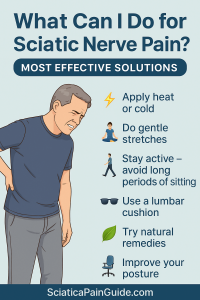What Can I Do for Sciatic Nerve Pain? (Most Effective Solutions)
🔥 Why Sciatica Pain Feels So Overwhelming
Sciatic nerve pain can feel like a lightning bolt shooting down your lower back, hip, or leg — making it difficult to sit, stand, sleep, or even focus on your day. Many people in the U.S. describe it as:
-
Sharp or electric pain
-
Burning or throbbing along the leg
-
A heavy, weak, or numb feeling
-
Pain that worsens after sitting too long
If you’ve ever thought, “What can I do for sciatic nerve pain?” — this guide gives you clear, fast, and realistic solutions you can use today. You’ll learn the most effective sciatica relief tips, gentle stretches, natural remedies, posture fixes, and long-term prevention strategies that actually make a difference.
⚡ Quick Answer: What Can I Do for Sciatic Nerve Pain Right Now?
If you’re in pain at this moment, start with these fast-acting relief steps:
-
Apply heat for muscle relaxation (heating pad or warm bath)
-
Use cold therapy for 10–15 minutes to calm inflammation
-
Walk for 5 minutes to release nerve pressure
-
Try gentle sciatic nerve glides
-
Avoid sitting for long periods
-
Use a lumbar cushion or rolled towel behind your lower back
Small adjustments like these can lower nerve compression and help decrease pain within minutes.
🔍 Why Sciatica Happens (And Why It Hurts So Much)
Sciatic nerve pain usually starts when something compresses or irritates the nerve, such as:
-
Herniated disc
-
Bulging disc
-
Piriformis muscle tightness
-
Spinal stenosis
-
Poor posture
-
Sedentary lifestyle
-
Heavy lifting with bad form
-
Pregnancy (pressure on pelvic nerves)
When the nerve becomes irritated, it sends pain signals down the leg — sometimes reaching the calf or foot.
🧘♀️ Gentle Stretches That Give Fast Relief
Stretches are one of the most effective answers to what can I do for sciatic nerve pain because they:
-
Reduce pressure
-
Improve blood flow
-
Relax tight muscles
-
Ease inflammation
-
Help the nerve glide smoothly
Try these U.S.-recommended stretches 1–2 times daily.
🪷 Piriformis Stretch (Huge Relief For Butt & Hip Pain)
-
Lie on your back
-
Bend one knee and cross the opposite ankle over it
-
Pull your legs toward your chest
-
Hold 20–30 seconds
-
Switch sides
🤸♂️ Knees-To-Chest Stretch
Great for decompressing the lower spine.
🧍♂️ Standing Hamstring Stretch
Flexible hamstrings reduce nerve tension dramatically.
🌀 Sciatic Nerve Glide
Not a stretch — a gentle movement that teaches the nerve to move freely.
-
Sit tall
-
Straighten your leg slowly
-
Flex your foot
-
Return to start
-
Repeat 10–15 reps
💺 Posture Fixes For Daily Relief
Poor posture is one of the most common causes of chronic sciatica.
🪑 Sitting Posture Tips (Especially for Office Workers in the U.S.)
-
Keep your feet flat on the ground
-
Add a lumbar cushion or rolled towel
-
Sit on a firm chair (avoid deep sofas)
-
Keep screens at eye level
-
Avoid crossing your legs
-
Stand up every 30–40 minutes
🧍 Standing Posture Tips
-
Keep shoulders relaxed
-
Slightly bend knees (avoid “locking” them)
-
Evenly distribute your weight
🖥️ Consider a Standing Desk
Many U.S. workers notice less pain when alternating between sitting and standing.
🏃♂️ Move More — Sciatica Hates Inactivity
Movement keeps the spine nourished and reduces inflammation. Even simple activities can help:
-
Light stretching
-
Swimming
-
Stationary cycling
-
Yoga for back pain
Avoid complete bed rest — it usually worsens nerve pain.
🧊 Heat vs Ice: Which Is Better?
Both help, but at different times.
🧊 Cold Packs (First 48 Hours When Pain Is Sharp)
Reduces inflammation and numbs pain.
🔥 Heat (When Muscles Feel Tight or Stiff)
Improves blood flow and relaxes muscles.
Alternate ice and heat for best results.
🌿 Natural Remedies Many U.S. Readers Find Helpful
Here are safe, science-backed options:
-
Turmeric/curcumin supplements (anti-inflammatory)
-
Magnesium glycinate (relaxes muscles)
-
Omega-3 fatty acids
-
CBD topical creams
-
Arnica gel
-
Epsom salt baths
Always check with a healthcare professional before starting supplements.
💪 Strengthening Exercises That Prevent Flare-Ups
You can reduce future pain significantly through core and hip strengthening.
Key Muscles to Strengthen
-
Abs
-
Glutes
-
Hip stabilizers
-
Lower back muscles
Great Beginner-Friendly Exercises
-
Bridges
-
Bird-dog
-
Clamshells
-
Pelvic tilts
-
Wall sits
Do them 3–4 times per week for ongoing relief.
🛏️ Sleep Positions That Reduce Nerve Pain
Sleep can either worsen or relieve sciatica.
Best Positions
-
On your side with a pillow between your knees
-
On your back with a pillow under your knees
-
Avoid stomach sleeping
Mattress & Pillow Tips
-
Choose medium-firm mattresses
-
Use supportive memory foam pillows
-
Consider a lumbar pillow for back sleepers
🔧 Home Products Many U.S. Readers Use for Relief
These tools often help reduce daily pain:
-
Lumbar support cushions
-
Seat wedges for cars
-
Standing desks
-
Massage guns
-
Ice/heat wraps
-
Back braces
-
Foam rollers
-
TENS units (electrical nerve stimulation)
These are widely available on Amazon, Walmart, or Target.
📉 Lifestyle Habits That Reduce Sciatica Long-Term
Small changes add up to major pain reduction.
Healthy Habits That Help
-
Maintain a healthy weight
-
Drink more water
-
Reduce long periods of sitting
-
Add daily mobility exercises
-
Wear supportive shoes
-
Avoid heavy lifting without proper form
Nutrition Tips
Choose anti-inflammatory foods:
-
Salmon
-
Leafy greens
-
Berries
-
Nuts
-
Olive oil
Avoid inflammatory foods:
-
Excess sugar
-
Processed foods
-
Fried foods
🧑⚕️ When Should You See A Doctor?
Seek medical or chiropractic care if you experience:
-
Pain lasting longer than 6 weeks
-
Sudden severe pain
-
Numbness or weakness in the leg
-
Difficulty walking
-
Loss of bladder or bowel control (emergency)
-
Pain after a fall or accident
A doctor may recommend:
-
Physical therapy
-
Cortisone injections
-
Imaging (MRI or X-ray)
-
Chiropractic adjustments
-
Advanced treatment options
❓ 7 FAQs Related to What Can I Do for Sciatic Nerve Pain?
1. What is the fastest way to relieve sciatic nerve pain?
Heat, short walks, nerve glides, and anti-inflammatory habits provide the quickest relief.
2. Should I walk or rest with sciatica?
Walk. Light movement is more effective than bed rest.
3. What triggers sciatic nerve pain the most?
Sitting too long, poor posture, lifting incorrectly, inactivity, and tight muscles.
4. Does stretching make sciatica worse?
Only if you overstretch, gentle stretches usually help.
5. How long does sciatica last?
Most mild cases improve within 2–6 weeks with consistent care.
6. Is massage good for sciatic nerve pain?
Yes — deep tissue and trigger point massage can relieve muscle tension.
7. Can stress make sciatica worse?
Yes. Stress increases muscle tension, which can aggravate nerve compression.
🌟 Conclusion: Small Daily Habits Lead to Big Pain Relief
If you’ve been wondering, “What can I do for sciatic nerve pain?” — remember that healing happens through consistent small steps:
-
Move more
-
Stretch gently
-
Strengthen your core
-
Improve posture
-
Avoid long sitting
-
Use heat/ice wisely
-
Support your lower back
Stay patient, stay consistent — and your body will begin to recover.
⚠️ Medical Disclaimer
This article is for informational purposes only and does not replace professional medical advice, diagnosis, or treatment. Always consult a qualified healthcare provider before starting any new treatment or exercise program.

- Can Acupuncture Help With Sciatica?
- Lifestyle Changes to Stop Sciatica from Returning
- What to Do for Sciatica Pain at Home





